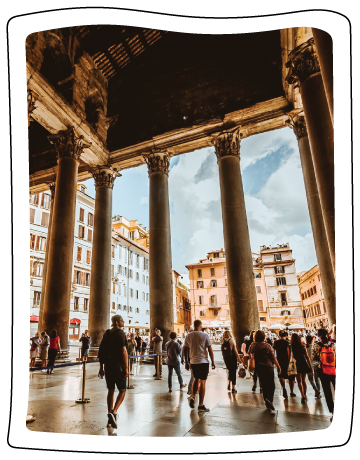Friendly disclaimer! We want to be as accurate as possible, but given these challenging times, we urge you to recheck that the venues are open when you decide to travel.
The coolest things about Rome, is what its locals have discovered, in the ruins of its two and a half thousand-year-old history. I’d urge you to take a detour off the main attractions and fulfill your curiosity for the odd, the eccentric and weird, to make your trip even more memorable.
Walk on Rome’s ancient cobblestoned road
Amazing to think the stones laid in 312 BCE have been trod upon for over 2000 years and waiting for you to walk on them. Via Appia Antica, conceived and named after Rome’s politically powerful Appius Claudius Caecus, is a 560 kilometer ‘empire connector’ full of Rome’s glorious history, from the centre of Rome to Brindisi, once the path for their armies and supplies.
Legend has it that when St Peter was fleeing, he met Jesus along this path. Today, restaurants and cafes line the street, but the fascinating tombs of wealthy Romans along the Appia will keep you admiring this route, with its perfectly laid millenia-old cobblestones under your feet.
Escape route of Popes
Another magical hidden treasure of the locals is the Quartiere Coppedè built by a Florentine architect between 1913 and 1926. This tiny neighbourhood leads from Via Tagliamento and Via Dora, and is a picture perfect treat for the senses. All around, you are surrounded by sculptures, facades and frescoes, Moorish arches, Gothic gargoyles, Tuscan turrets, and palm-fringed gardens. The best way to get here is by taking trams 3 or 19 to Piazza Buenos Aires.
What’s under the Colosseum Arena?
Experience the Colosseum from a gladiator’s point of view! Go back to the 5th century where wild lions, tigers, hyenas, and bears were caged, where slaves worked, and see where gladiators rested, ate, and prayed. Small private tours gets you to a ringside view of the Colosseum and unique views of the huge interiors inside and out towards Rome. Without the crowds! And, worth a visit just opposite the Colosseum is the Domus Aurea – the hidden underground palace of the notorious Emperor Nero.

Fairy-tale quarter at Quartiere Coppedè
Another magical hidden treasure of the locals is the Quartiere Coppedè built by a Florentine architect between 1913 and 1926. This tiny neighbourhood leads from Via Tagliamento and Via Dora, and is a picture perfect treat for the senses. All around, you are surrounded by sculptures, facades and frescoes, Moorish arches, Gothic gargoyles, Tuscan turrets, and palm-fringed gardens. The best way to get here is by taking trams 3 or 19 to Piazza Buenos Aires.
The magic door at Piazza Vittorio
Dive into 1600’s, when alchemy and mysticism ruled. And be thankful this isn’t the time of The Inquisition, when practitioners were persecuted or executed! The original Piazza Vittorio (now a part called Villa Palombara), was the lair of the wealthy Marquis of Pietraforte, a well-known practitioner of alchemy who with his friend Borri, conducted experiments to find the Philosopher’s Stone, which could turn metal into gold.
Legend has it that Borri found the solution, but had to escape the inquisition, fleeing into the night. He left his formula behind, which the Marquis perhaps, inscribed onto the frame of the door for posterity. This curious door is guarded by two odd Egyptian statues at the entrance of the laboratory.
The meridian line of Santa Maria
When the sun was still shining on the Roman Empire, Pope Clement XI commissioned the astronomer and mathematician, Francesco Bianchini to build a meridian line inside the basilica, fundamentally to check the accuracy of the Gregorian reformation calendar. He built this sundial along the meridian that crosses Rome. Depending on the time of year you may visit, the sun’s noon beam hits a small hole in the wall above, landing on the meridian line.
At the summer solstice, the ray of light can be seen to hit the meridian line at the point nearest the wall and in the winter solstice, the sun hits the farthest point on the meridian from the wall. And in the spring and autumnal equinoxes, the sunbeam lands just between these two points. Pretty accurate to this day!
Keats died here
Check out the epitaph of poet and writer John Keats, at the 26 Piazza di Spagna – a museum and memorial dedicated to the famed poets Keats and his contemporary, Percy Bysshe Shelley. Keats died here at 25, of tuberculosis, on February 23, 1821, and his deathbed is still preserved as a shrine to the writer. It hosts a variety of memorabilia from both poets. P.B. Shelley is also included because of his relationship with the city of Rome.
The museum has an extensive collection from the Romantic era poets and includes a library with over 8,000 examples of Romantic literature and a small cinema room too. The house is a national historic landmark and sits at the b of the afterlife, because, according to legend, you may hear the voice of the doomed poet along with some mysterious phenomena such as unexplained lights and cold spots. Spooky we say!
Unravelog tip: The museum now has hour-long online tours for 6 Euros. Get your tickets to this digital experience here!
Do you now want to continue on this magical quest for the offbeat in Rome, and for longer? We have a trip plan carved out for you to satiate the adventurer in you. Check out how to unravel Rome in 3 days!







